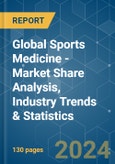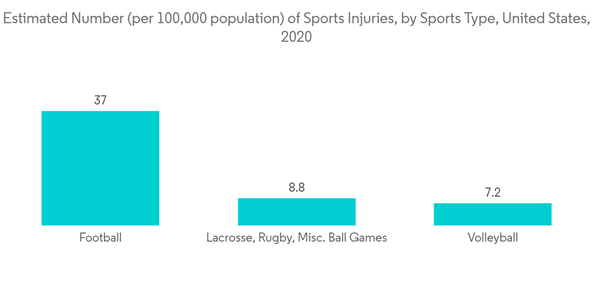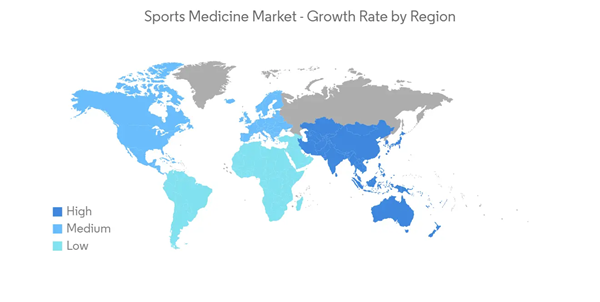The Global Sports Medicine Market size is estimated at USD 7.97 billion in 2024, and is expected to reach USD 9.11 billion by 2029, growing at a CAGR of 2.71% during the forecast period (2024-2029).
The COVID-19 outbreak is an unprecedented health concern and has significantly impacted the sports medicine market worldwide. Sports have been classified based on their contact nature. Thus, several sports activities were on hold, and some were postponed during the pandemic, thereby impacting the growth of the market in the first quarter of 2020. According to a 2021 update by the National Safety Council (NSC) in America, the Consumer Product Safety Commission (CPSC) reports that during the first seven months of the COVID-19 pandemic, visits to emergency departments for consumer product-related injuries fell by 24%. The highest decrease in injuries were sports-related injuries associated with track and field. Hockey, soccer, baseball, football, and basketball witnessed a reduction of more than 60% from March through September 2020. As per the CPSC, these large decreases were due to the suspension of school and youth sports leagues in the spring and summer months of 2020 in response to the pandemic. These developments impacted the demand for sports medicine across the world.
To curb the disease, most international, regional, and national level sports activities have been postponed, which has led to fewer sports injuries, and thereby, a decline in demand for sports medicine. For instance, in April 2020, the Confederation of Africa Football announced its plan to shift the African Champion's League's semi-finals due to the outbreak of COVID-19. This factor restricted the sales of companies in this region. Similarly, other countries in other geographies have also been affected. Therefore, a short-term negative impact can be expected on the market growth due to COVID-19. However, in the coming years, the market studied grew as sports activities surged by the end of 2021.
Furthermore, the factors that are fueling the market include the rising burden of sports injuries, consistent innovation of new products and treatment modalities, and rising demand for minimally invasive surgeries. According to the article published by Sarah Megginson in February 2020, 89% of Australian adults participate in sports every year, with 62% participating at least three times a week. Furthermore, in 2019, a study published by Wu Jianxi et al. in the International Journal of Sports and Exercise Medicine reported that the increasing popularization of futsal in China led to the highest number of ankle-related injuries, as futsal is a whole-body contact sport of technical confrontation. Thus, with the rising number of sports injuries, the demand for sports medicine is also expected to increase across the world.
The launches of novel products related to sports medicine are also expected to propel the market's growth over the forecast period. For instance, in September 2020, Smith and Nephew launched its new product, ''HEALICOIL KNOTLESS Suture Anchor'', in the market. This product, in combination with REGENESORB Material, supports in-bone formation and healing. Hence, the increasing number of product approvals is also expected to boost market growth.
However, the high cost of implants and devices and the dearth of a proper sports ecosystem are the factors hindering the growth of the market.
As per the data provided by the Nations Safety Council, about 122.7 per 100,000 people got injured in basketball games. This number is expected to decrease as most of the sports activities got postponed in 2020.
As a result, many organizations are taking definite measurements related to sports medicines. For instance, in April 2020, Aspetar, an orthopedic and sports medicine hospital situated in Qatar, launched the "COVID-19 Evidence for Athletes Service'', a platform that will provide information on sports medicines (including braces) to athletes, their healthcare teams, coaches, etc.
A brace plays an important role in recovery from a fracture by allowing limited joint mobility, increased muscle activity, and the needed continuous support to regain full range of motion. New product developments by companies are expected to accelerate the market growth in this segment. For instance, in February 2020, a startup, Cast 21, developed a novel waterproof cast. Thus, due to the above-mentioned developments, the market is expected to grow in this segment.
The COVID-19 pandemic has significantly impacted the sports medicine market in the United States. Initially, the surgeries (including surgeries related to sports injuries) were put on hold, which impacted the demand for sports medicines negatively. According to a research article by Francesca Vannini et al., published in the International Orthopaedics Journal, in August 2020, during the initial spread of the novel coronavirus, elective surgery was stopped, and only emergency procedures were allowed. In response to this outbreak, the Centers for Disease Control and Prevention issued guidelines in December 2020 to conduct sports activities safely and prevent the transmission of the virus, including limiting in-person contact, wearing masks, and using own equipment such as headgears.
Additionally, as per the 2021 statistics by the Brain Injury Research Institute, about 1.6 million to 3.8 million recreation and sport-related concussions occur each year in the United States. Hence, this factor may contribute to the increasing demand for sports medicine. With rising sports injuries, the incidence rate of visiting hospitals and doctors for the treatment of these injuries is increasing, subsequently boosting the demand for sports medicines.
Moreover, in August 2021, Bioventus Inc., a global leader in innovations for active healing, completed a strategic investment in Trice Medical Inc., a company focused on developing and commercializing minimally invasive technologies for sports medicine and orthopedic surgical procedures.
Hence, due to the above-mentioned developments, the market is expected to grow during the forecast period.
This product will be delivered within 2 business days.
The COVID-19 outbreak is an unprecedented health concern and has significantly impacted the sports medicine market worldwide. Sports have been classified based on their contact nature. Thus, several sports activities were on hold, and some were postponed during the pandemic, thereby impacting the growth of the market in the first quarter of 2020. According to a 2021 update by the National Safety Council (NSC) in America, the Consumer Product Safety Commission (CPSC) reports that during the first seven months of the COVID-19 pandemic, visits to emergency departments for consumer product-related injuries fell by 24%. The highest decrease in injuries were sports-related injuries associated with track and field. Hockey, soccer, baseball, football, and basketball witnessed a reduction of more than 60% from March through September 2020. As per the CPSC, these large decreases were due to the suspension of school and youth sports leagues in the spring and summer months of 2020 in response to the pandemic. These developments impacted the demand for sports medicine across the world.
To curb the disease, most international, regional, and national level sports activities have been postponed, which has led to fewer sports injuries, and thereby, a decline in demand for sports medicine. For instance, in April 2020, the Confederation of Africa Football announced its plan to shift the African Champion's League's semi-finals due to the outbreak of COVID-19. This factor restricted the sales of companies in this region. Similarly, other countries in other geographies have also been affected. Therefore, a short-term negative impact can be expected on the market growth due to COVID-19. However, in the coming years, the market studied grew as sports activities surged by the end of 2021.
Furthermore, the factors that are fueling the market include the rising burden of sports injuries, consistent innovation of new products and treatment modalities, and rising demand for minimally invasive surgeries. According to the article published by Sarah Megginson in February 2020, 89% of Australian adults participate in sports every year, with 62% participating at least three times a week. Furthermore, in 2019, a study published by Wu Jianxi et al. in the International Journal of Sports and Exercise Medicine reported that the increasing popularization of futsal in China led to the highest number of ankle-related injuries, as futsal is a whole-body contact sport of technical confrontation. Thus, with the rising number of sports injuries, the demand for sports medicine is also expected to increase across the world.
The launches of novel products related to sports medicine are also expected to propel the market's growth over the forecast period. For instance, in September 2020, Smith and Nephew launched its new product, ''HEALICOIL KNOTLESS Suture Anchor'', in the market. This product, in combination with REGENESORB Material, supports in-bone formation and healing. Hence, the increasing number of product approvals is also expected to boost market growth.
However, the high cost of implants and devices and the dearth of a proper sports ecosystem are the factors hindering the growth of the market.
Sports Medicine Market Trends
Braces are Expected to Observe Good Growth over the Forecast Period
By product, the braces segment is expected to witness healthy growth. According to the United Nations article, in May 2020, the Olympics and Paralympics were postponed to 2021 due to the spread of COVID-19 across the world. However, with activities resuming now, including sports, the risk of sports-related injuries increases. Hence, the need for cast braces is expected to increase in the coming years.As per the data provided by the Nations Safety Council, about 122.7 per 100,000 people got injured in basketball games. This number is expected to decrease as most of the sports activities got postponed in 2020.
As a result, many organizations are taking definite measurements related to sports medicines. For instance, in April 2020, Aspetar, an orthopedic and sports medicine hospital situated in Qatar, launched the "COVID-19 Evidence for Athletes Service'', a platform that will provide information on sports medicines (including braces) to athletes, their healthcare teams, coaches, etc.
A brace plays an important role in recovery from a fracture by allowing limited joint mobility, increased muscle activity, and the needed continuous support to regain full range of motion. New product developments by companies are expected to accelerate the market growth in this segment. For instance, in February 2020, a startup, Cast 21, developed a novel waterproof cast. Thus, due to the above-mentioned developments, the market is expected to grow in this segment.
North America is Expected to Contribute a Significant Share in the Sports Medicine Market
Within North America, the United States is expected to dominate the sports medicine market. The major factors contributing to the market growth are technological advancements, a rising number of sports injuries, and awareness initiatives.The COVID-19 pandemic has significantly impacted the sports medicine market in the United States. Initially, the surgeries (including surgeries related to sports injuries) were put on hold, which impacted the demand for sports medicines negatively. According to a research article by Francesca Vannini et al., published in the International Orthopaedics Journal, in August 2020, during the initial spread of the novel coronavirus, elective surgery was stopped, and only emergency procedures were allowed. In response to this outbreak, the Centers for Disease Control and Prevention issued guidelines in December 2020 to conduct sports activities safely and prevent the transmission of the virus, including limiting in-person contact, wearing masks, and using own equipment such as headgears.
Additionally, as per the 2021 statistics by the Brain Injury Research Institute, about 1.6 million to 3.8 million recreation and sport-related concussions occur each year in the United States. Hence, this factor may contribute to the increasing demand for sports medicine. With rising sports injuries, the incidence rate of visiting hospitals and doctors for the treatment of these injuries is increasing, subsequently boosting the demand for sports medicines.
Moreover, in August 2021, Bioventus Inc., a global leader in innovations for active healing, completed a strategic investment in Trice Medical Inc., a company focused on developing and commercializing minimally invasive technologies for sports medicine and orthopedic surgical procedures.
Hence, due to the above-mentioned developments, the market is expected to grow during the forecast period.
Sports Medicine Industry Overview
The sports medicine market is dominated by a few major players and is moderately competitive. The major players in this market are Medtronic PLC, CONMED Corporation, Smith & Nephew PLC, and Stryker Corporation. Furthermore, with technological innovations in implants and the growing price competition, some new companies are also penetrating the market.Additional Benefits:
- The market estimate (ME) sheet in Excel format
- 3 months of analyst support
This product will be delivered within 2 business days.
Table of Contents
1 INTRODUCTION
4 MARKET DYNAMICS
5 MARKET SEGMENTATION (Market Size by Value-USD Million)
6 COMPETITIVE LANDSCAPE
Companies Mentioned (Partial List)
A selection of companies mentioned in this report includes, but is not limited to:
- Arthrex Inc.
- CONMED Corporation
- Johnson & Johnson
- Medtronic PLC
- Mueller Sports Medicine Inc.
- Performance Health
- Smith & Nephew
- Stryker Corporation
- Wright Medical Group
- Zimmer Biomet Holdings Inc.
- Breg, Inc.
- DJO Global Inc.
Methodology

LOADING...










